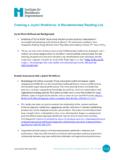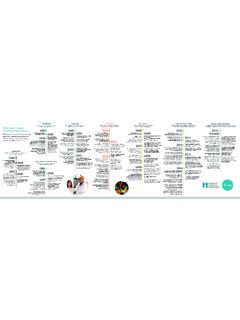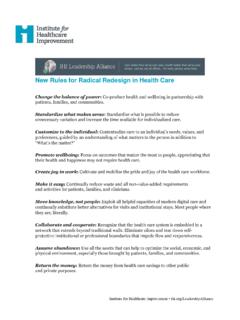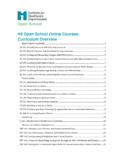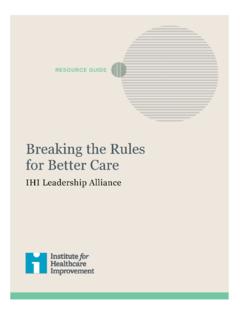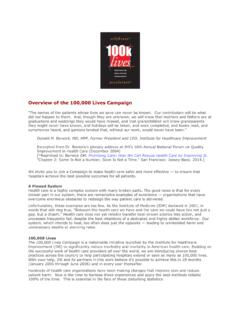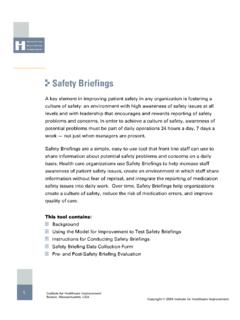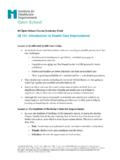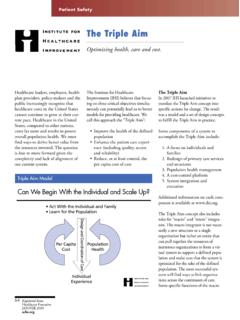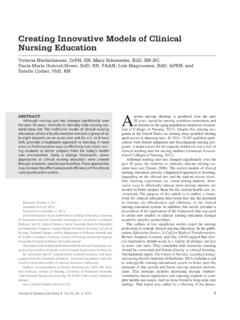Transcription of Transforming Care at the Bedside - IHI
1 Transforming care at the Bedside How-to Guide: Developing Front-Line nursing Managers to Lead Innovation and Improvement Transforming care at the Bedside (TCAB) is a national effort of the Robert Wood Johnson Foundation and Institute for Healthcare Improvement designed to improve the quality and safety of patient care on medical and surgical units, to increase the vitality and retention of nurses, and to improve the effectiveness of the entire care team. For more information, go to or Copyright 2008 Institute for Healthcare Improvement All rights reserved. Individuals may photocopy these materials for educational, not-for-profit uses, provided that the contents are not altered in any way and that proper attribution is given to IHI as the source of the content. These materials may not be reproduced for commercial, for-profit use in any form or by any means, or republished under any circumstances, without the written permission of the Institute for Healthcare Improvement.
2 How to cite this document: Lee B, Peck C, Rutherford P, Shannon D. Transforming care at the Bedside How-to Guide: Developing Front-Line nursing Managers to Lead Innovation and Improvement. Cambridge, MA: Institute for Healthcare Improvement; 2008. Available at: Transforming care at the Bedside How-to Guide: Developing Front-Line nursing Managers to Lead Innovation and Improvement Institute for Healthcare Improvement, 2008 2 Acknowledgements Support for this publication was provided by a grant from the Robert Wood Johnson Foundation through Transforming care at the Bedside , a national program of the Robert Wood Johnson Foundation and the Institute for Healthcare Improvement. The Robert Wood Johnson Foundation (RWJF) focuses on the pressing health and health care issues facing our country. As the nation's largest philanthropy devoted exclusively to improving the health and health care of all Americans, the Foundation works with a diverse group of organizations and individuals to identify solutions and achieve comprehensive, meaningful, and timely change.
3 For more than 30 years the Foundation has brought experience, commitment, and a rigorous, balanced approach to the problems that affect the health and health care of those it serves. When it comes to helping Americans lead healthier lives and get the care they need, the Foundation expects to make a difference in your lifetime. The Institute for Healthcare Improvement (IHI) is a not-for-profit organization leading the improvement of health care throughout the world. Founded in 1991 and based in Cambridge, MA, IHI is a catalyst for change, cultivating innovative concepts for improving patient care and implementing programs for putting those ideas into action. Thousands of health care providers, including many of the finest hospitals in the world, participate in IHI s groundbreaking work. Transforming care at the Bedside Faculty/Co-Authors Betsy Lee, RN, MSPH, Director, Indiana Hospital Association (Lead Author) Carrie Peck, Project Manager, Institute for Healthcare Improvement Pat Rutherford, MS, RN, Vice President, Institute for Healthcare Improvement Diane W.
4 Shannon, MD, MPH, Writer Transforming care at the Bedside How-to Guide: Developing Front-Line nursing Managers to Lead Innovation and Improvement Institute for Healthcare Improvement, 2008 3 Contributors The work of several individuals at leading organizations has informed the development of this guide. Cedars-Sinai Medical Center, Los Angeles, California James A. Haley Veterans Hospital, Tampa, Florida Kaiser Permanente Roseville Medical Center, Roseville, California Long Island Jewish Medical Center, New Hyde Park, New York Prairie Lakes Healthcare System, Watertown, South Dakota Seton Northwest Hospital, Austin, Texas ThedaCare, Appleton, Wisconsin University of Pittsburgh Medical Center Shadyside, Pittsburgh, Pennsylvania The University of Texas MD Anderson Cancer Center, Houston, Texas How to cite this document Lee B, Peck C, Rutherford P, Shannon D. Transforming care at the Bedside How-to Guide: Developing Front-Line Managers to Lead Innovation and Improvement.
5 Cambridge, MA: Institute for Healthcare Improvement; 2008. Available at: Transforming care at the Bedside How-to Guide: Developing Front-Line nursing Managers to Lead Innovation and Improvement Institute for Healthcare Improvement, 2008 4 Introduction to TCAB Launched in 2003, Transforming care at the Bedside (TCAB) is a national program of the Robert Wood Johnson Foundation (RWJF) and the Institute for Healthcare Improvement (IHI) that engages leaders at all levels of the health care organization to: Improve the quality and safety of patient care on medical and surgical units; Increase the vitality and retention of nurses; Engage and improve the patient s and family members experience of care ; and Improve the effectiveness of the entire care team. As of September 2007, the ten hospitals participating in phase III of TCAB received technical assistance from IHI faculty, which consisted of individuals selected for their expertise in quality improvement, innovation, change management, transformational learning, and change strategies.
6 With the support of these faculty members, the TCAB hospitals were charged with dramatically improving performance through a focus on five design themes: Transformational Leadership Safe and Reliable care Vitality and Teamwork Patient-Centered care Value-Added care Processes The hospitals participated in phase III of TCAB by creating and testing new concepts, developing exemplary care models on medical-surgical units, demonstrating institutional commitment to the program, and pledging resources to support and sustain these innovations. A number of hospital teams across the United States have joined these ten initial participants in applying TCAB principles and processes to dramatically improve the quality of patient care on medical and surgical units. Newer participants include more than 60 hospitals in IHI s Learning and Innovation Community, also called Transforming care at the Bedside , and 67 hospitals in the American Organization of Transforming care at the Bedside How-to Guide: Developing Front-Line nursing Managers to Lead Innovation and Improvement Institute for Healthcare Improvement, 2008 5 Nurse Executives (AONE) TCAB program.
7 For more information on the TCAB programs and participating sites, please see the following: IHI website RWJF TCAB brochure RWJF TCAB Toolkit AONE website Figure 1: The Transforming care at the Bedside Framework This TCAB How-to Guide is one in a series of Guides describing improvements in the Vitality and Teamwork theme of Transforming care at the Bedside . In TCAB Vitality Transforming care at the Bedside How-to Guide: Developing Front-Line nursing Managers to Lead Innovation and Improvement Institute for Healthcare Improvement, 2008 6 symbolizes far more than just staff satisfaction. Vitality includes a transformative shift in the attitudes and engagement of nurses and other staff on the TCAB units. The TCAB vision aims to re-capture true joy in work as well as enhanced teamwork, engagement, and commitment amongst the multidisciplinary team. In addition to promoting staff retention, a truly vital unit actually draws other staff to join its ranks, sometimes resulting in a waiting list of applicants and the virtual elimination of voluntary turnover.
8 This How-to Guide describes the innovative changes that hospitals tested and implemented to develop the talent and competencies of their front-line nurse managers on the TCAB units. These changes focus on tactics to improve the abilities of managers to support transformational change, including strategies for manager self-assessment and development. Specifically, this Guide describes a four-pronged strategy for developing transformational leadership skills. This approach, based on knowledge gained from the experience of both participants and leaders in TCAB and the IHI Achieving Workforce Excellence Collaborative, requires that organizational leaders: Use a talent management framework; Provide access to formalized nursing leadership development programs; Develop leaders emotional intelligence; and Foster effective succession planning. The Guide illustrates the practical implementation of this strategy for developing transformational leadership skills with a pair of case studies.
9 This How-to Guide is divided into three sections: Section One provides the background and rationale for why it is so important to develop new types of skills and competencies for nurse leaders during periods of rapid change in health care . Lessons from other industries and the business literature provide a framework for the changes tested in the TCAB hospitals. Transforming care at the Bedside How-to Guide: Developing Front-Line nursing Managers to Lead Innovation and Improvement Institute for Healthcare Improvement, 2008 7 Section Two outlines key talent management steps to assist front-line managers with self-assessment, planning developmental opportunities, and the importance of enhancing emotional intelligence among nursing leaders. Section Three includes case studies from Prairie Lakes Hospital and Long Island Jewish Medical Center. Transforming care at the Bedside How-to Guide: Developing Front-Line nursing Managers to Lead Innovation and Improvement Institute for Healthcare Improvement, 2008 8 Section One The Rationale for Improving Front-line Leadership in Medical-Surgical Units Years ago staff nurses were promoted to management positions based on clinical skills and technical competencies.
10 As a result, front-line managers were not adequately skilled to address the array of interpersonal issues and complex, ever-changing priorities. The selection process for today s front-line nursing managers is far more robust than in years past, often requiring advanced degrees and leadership experience. Changes to the hiring and development models are imperative to address the rapid changes in the clinical, technical, and social changes in the health care workplace. Ill-prepared nursing leaders may negatively affect the vitality of staff. In their ground-breaking book First, Break All the Rules: What the World s Greatest Managers Do Differently, Buckingham and Coffman stress the important role that front-line managers play in attracting and retaining talented employees. They emphasize that individuals may choose a job based on the position, but leave based on the actions, demeanor, and skills of their supervisor. Buckingham M, Coffman C.
